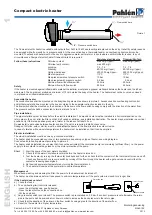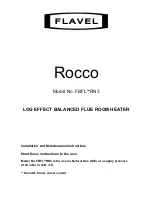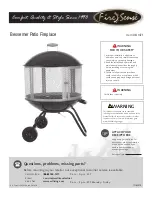
27
barb, use a wire tie or hose clamp (not supplied with kit)
and secure.
6. Take the other end of the flexible tubing and slide it through
the hose clamp on the jacket top cover and install it into one
of the four barb fittings in vent pipe assembly #2.
7. Once installed along with the rest of the vent configuration, make
sure to operate the unit through at least one heat up cycle to
ensure there is no leakage around the hose barb or any joints
of the VAA or vent pipe system.
FIGURE 23: Typical Horizontal Installation
Installation for VAA with 3 & 4 inch Pipe for Vertical Vent
Some applications may require the use of 3 or 4 inch vent pipe for
longer vent lengths. Please refer to Figure 24 as you review these
instructions. Refer back to the vertical VAA installation steps but with
the following changes to the vent construction.
3 inch vent (Vertical VAA Installations)
The VAA is designed to accommodate only 2 inch vent pipe. The
installer must use 2 inch vent pipe between the blower assembly
and the inlet into the VAA. On the outlet side of the VAA, a short
run of 2 inch vent pipe is required. Each of the short pieces of 2
inch pipe entering and exiting the VAA must not exceed 6 inches
(15 cm) in length. From this point on, a 2 inch to 3 inch adapter
may be used. From the 2 inch to 3 inch adapter, the installer may
use up to 65 equivalent feet (19.8 m) of pipe, see Figure 24 for
typical installation.
4 inch vent (Vertical VAA Installations)
The VAA is designed to accommodate only 2 inch vent pipe. The
installer must use 2 inch vent pipe between the blower assembly
and the inlet into the VAA. On the outlet side of the VAA, a short
run of 2 inch vent pipe is required. Each of the short pieces of 2
inch pipe entering and exiting the VAA must not exceed 6 inches
(15 cm) in length. From this point on, a 2 inch to 4 inch adapter
may be used. From the 2 inch to 4 inch adapter, the installer may
use up to 128 equivalent feet (39.0 m) of pipe, see Figure 24 for
typical installation.
Remember to operate the unit for at least one heat cycle to
ensure there are no air leaks in the vent joints of the VAA and
the vent pipe system. Air leaks will allow flue gas by-products to
disseminate into the room creating an unsafe environment and
could cause illness, asphyxiation and/or even death.
FIGURE 24: Typical Installation for Vertical Vent with 3 or 4 inch Pipe
Installation of VAA with 3 & 4 inch Pipe for Horizontal Vent
Some applications may require the use of 3 or 4 inch vent pipe for
longer vent lengths. Please refer to the Figure 25 as you review these
instructions. Refer back to the horizontal VAA installation steps but
with the following changes to the vent construction.
3 inch vent (Horizontal VAA Installations)
The VAA is designed to accommodate only 2 inch vent pipe. The
installer must use 2 inch vent pipe between blower assembly and inlet
into the VAA. On the outlet side of the VAA, a short run of 2 inch vent
pipe is required. From this point on, a 2 inch to 3 inch adapter may
be used. From the 2 inch to 3 inch adapter, installer may use up to 52
equivalent feet (15.8 m) of pipe. This is 8 equivalent feet (2.4 m) less
than the original 60 equivalent feet (18.3 m) specified with one elbow
due to the 2 inch elbow instead of a 3 inch elbow required for vent from
blower to the inlet of VAA, see Figure 25 for typical installation.
4 inch vent (Horizontal VAA Installations)
The VAA is designed to accommodate only 2 inch vent pipe. The installer
must use 2 inch vent pipe between the blower assembly and the inlet into
the VAA. On the outlet side of the VAA a short run of 2 inch vent pipe is
required. From this point on, a 2 inch to 4 inch adapter may be used. From
the 2 inch to 4 inch adapter, the installer may use up to 102 equivalent feet
(31.1 m) of pipe. This is 18 equivalent feet (5.5 m) less than the original
120 equivalent feet (36.6 m) specified with one elbow due to the 2 inch
elbow instead of a 4 inch elbow required for the vent from the blower to
the inlet of the VAA, see Figure 25 for typical installation.
Remember to operate the unit for at least one heat cycle to ensure
there are no air leaks in the vent joints of the VAA and the vent pipe
system. Air leaks will allow flue gas by-products to disseminate
into the room creating an unsafe environment and could cause
illness, asphyxiation and/or even death.
FIGURE 25: Typical Installation for Horizontal Vent with 3 or 4 inch Pipe
Содержание 110
Страница 8: ...8 TYPICAL INSTALLATION CONDENSATE HOSE AND DRAIN PAN FIGURE 1 continued ...
Страница 40: ...40 NOTES ...
Страница 41: ...41 NOTES ...
Страница 42: ...42 NOTES ...
















































